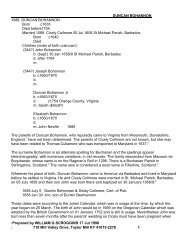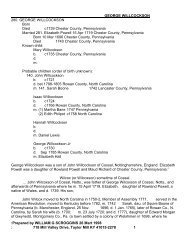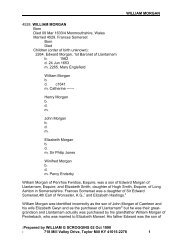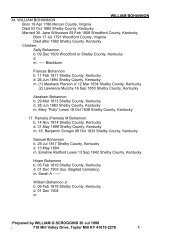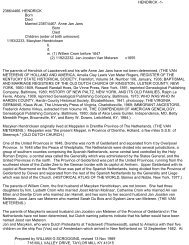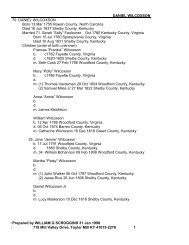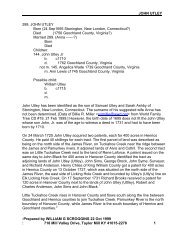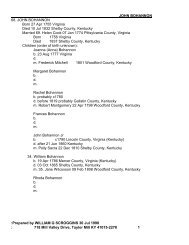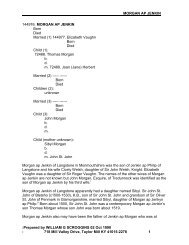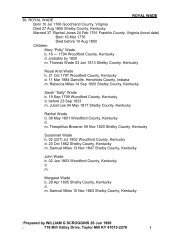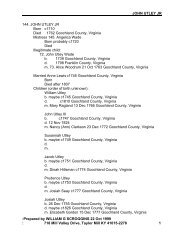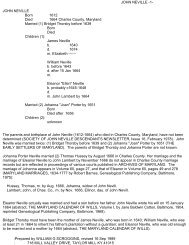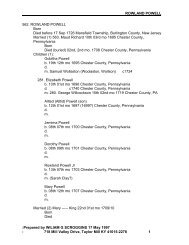SOMERSET - Genealogy Research Papers
SOMERSET - Genealogy Research Papers
SOMERSET - Genealogy Research Papers
Create successful ePaper yourself
Turn your PDF publications into a flip-book with our unique Google optimized e-Paper software.
<strong>SOMERSET</strong><br />
London (Hackney),” aged about 62, and was buried at Raglan Castle on 30 April. His<br />
will, dated 03 February 1588/9, directed that he be “buried in the parish church of<br />
Ragland there to lye alone.” The will was probated on 07 November 1589. The<br />
monument to Sir William was seen in July 1645 by Richard Symonds who copied the<br />
date therefrom in his diary. It and the other tombs of the Somerset family were<br />
demolished a year later in the destruction of Raglan Castle. A commemorative plate<br />
listing the names of those buried in the vault was placed in the Beaufort Chapel at<br />
Raglan in 1868.<br />
Hackney is a community directly north of the City of London (old London) on the<br />
Kingsland Road (A10) within the limits of modern, metropolitan London.<br />
A 3/4-length portrait, dated 1569, of William Somerset at Badminton, aged 44 and<br />
dressed in a suit of gold-enriched armor, was exhibited at South Kensington in 1866.<br />
The involvement of William Somerset with the struggle for power in England, through<br />
the reigns of several monarchs, did not appear to affect his fortunes adversely. He was<br />
with King Henry VIII at Boulogne in 1544 and there again in 1546 with Sir Edward<br />
Seymour, who became the Earl of Hertford. An esquire of the body to Henry VIII,<br />
Seymour’s rank and influence advanced quickly after his sister Jane Seymour, who had<br />
been maid of honor to Anne Boleyn when she married Henry VIII in 1533, became the<br />
third wife of the king. Queen Anne was beheaded in 1536 and Jane, daughter of Sir<br />
John Seymour, married Henry the same year. Jane, who died in 1537, was the only wife<br />
for whom Henry VIII showed any regret over her death. Her brother Edward was<br />
elevated to Earl of Hertford in 1537 and, ten years later, to Duke of Somerset. At that<br />
time, he was Regent for young King Edward VI, who succeeded his father to the throne<br />
at age nine.<br />
The speed of Seymour’s rise to power soon was exceeded by the rapidity of his fall from<br />
grace. Two egregious mistakes sealed his doom. He signed the death warrant for the<br />
execution of his brother Thomas Seymour, Baron Seymour of Sudely, and he<br />
demolished churches and dug up graveyards, causing the bones to be carried away to<br />
the fields with the rubble, to make room, and provide construction materials, for a new<br />
building which he named Somerset House. He was arrested and stripped of power and<br />
assets but he soon persuaded the young king to restore him. The reconciliation with his<br />
enemies, led by John Dudley, Earl of Warwick and Duke of Northumberland, was shortlived<br />
when he was accused of plotting to kill Dudley. Arrested again, he was arraigned<br />
on five charges:<br />
1. Of raising men in the northern parts of the realm.<br />
2. Of assembling men to kill the Duke of Northumberland.<br />
3. Of resisting his attachment.<br />
4. Of killing the “gens d’armes” and raising (razing?) London.<br />
5. Of assaulting the lords and devising their deaths.<br />
Seymour pled not guilty and was acquitted of treason but convicted of felony and<br />
:Prepared by WILLIAM G SCROGGINS, 02 Mar 1997<br />
: 718 Mill Valley Drive, Taylor Mill KY 41015-2278 8



